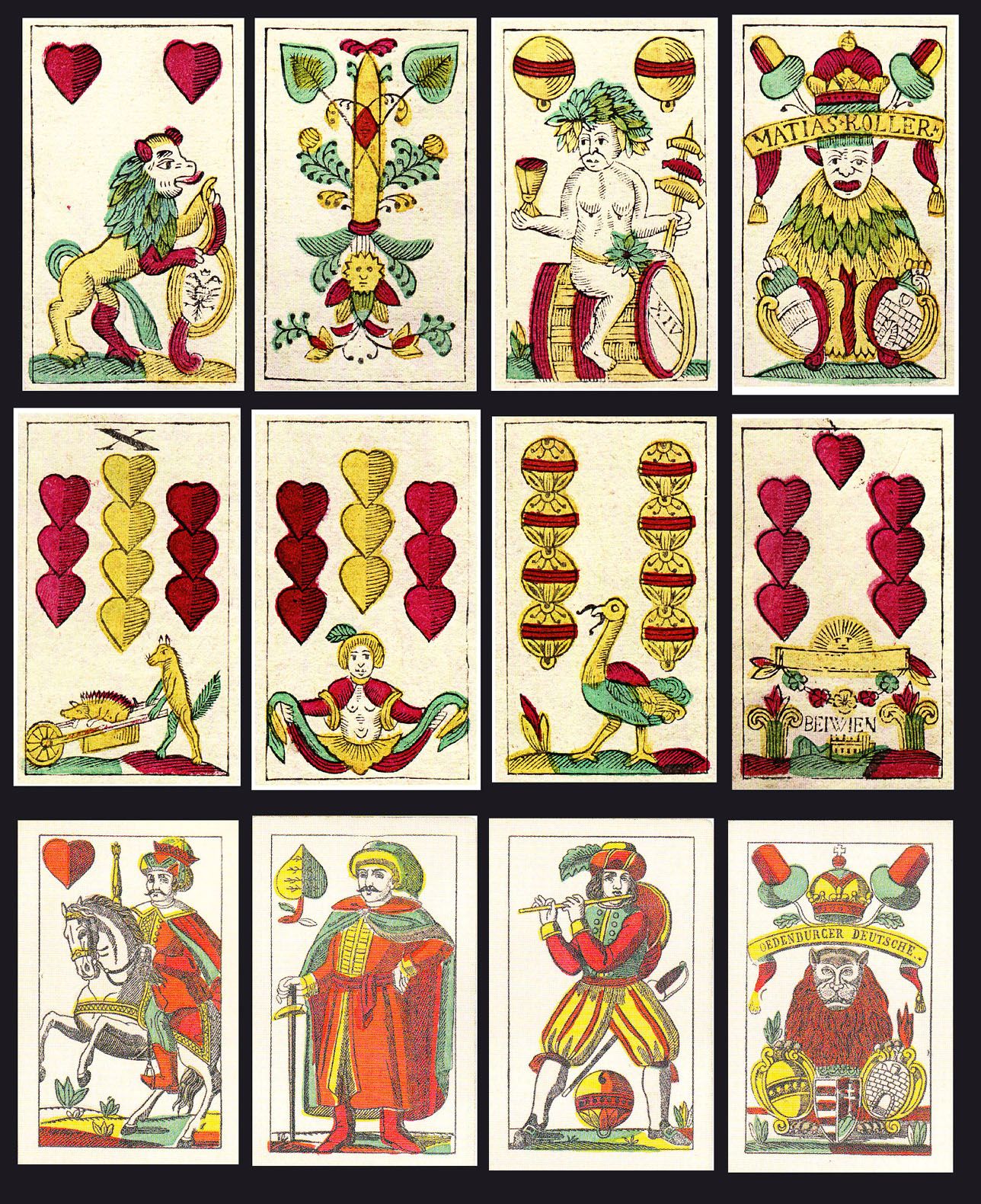

| Suit System: | G |
| Recommended name: | Sopron pattern |
Alternative name: Oedenburger-Deutsche.
The rather small city of Sopron (Oedenburg in German language) is located in Western Hungary, about 50 km south-east of Vienna. The recommended name stems from two wrappers made around 1865 in Vienna by Josef Glanz and Johann Nejedly, and from a Daus of Acorns by “Elsö Magyar Kártyagyár Részvénytársulat, Budapest” (First Hungarian playing card factory) in 1883. The pattern emerged at the end of the 18th century – from this time a pack made by Johann Obermayer in Vienna is known, showing most Daus and court cards equal to the slightly later standard drawings. Klaus Reisinger – the late expert in card patterns of the Austrian empire, whose research is reflected here – mentions this, and two more similar packs as forerunners: one made c.1800 by Anna Scrusina in Neustadt an der Waag (as stated on her pack) in Hungary (there called Vágújhely), the other c.1810 in Vienna by Johann Norbert Hofmann. The oldest known pack with the standard pattern is made by Mathias Koller in Vienna around 1810, further early packs follow c.1824 by Johann Wagner in Pest, Franz Schell in Neutra in Slovakia (Nyitra, Nitra), Mathias Unger in Raab (Györ) and c.1830 by Michael Nitsch in Pest. Most pattern details are derived from various older packs, showing influences of motifs from Nuremberg, Augsburg, Ansbach, Munich, Prague and Vienna. Card players in Lower Austria with Vienna, in Styria and particularly in Hungary used this pattern almost for hundred years, until the end of the 19th century.
Daus-cards: on Hearts a lion with a coat of arms; on Leaves some foliage sprouts out of a stick, below is a small eagle; on Bells a Bacchus sitting astride of a barrel holds a spit with three sausages; on Acorns a lion (or a bear) holds two or three coats of arms. The kings are sitting on horseback, the Obers and Unters are presented as cavaliers, musicians, Orientals, and a miner. Most peculiar motifs are: on the Ten of Hearts a fox pushes a wheelbarrow with a hedgehog in it; on the Nine of Hearts a woman with two fish-tails; on the Nine of Bells a donkey laden by a sack; on the Eight of bells an ostrich bearing a horseshoe in his mouth; on the Seven of Hearts a rising sun with a human face, and the maker’s name written in the sunrays; seldomly an eagle holds a banderol instead.
36 cards: Daus, King, Ober, Unter, X to VI. 32 cards: as 36 cards, but minus the VI cards.
Apart from those mentioned above: Emil Hirschfeld in Graz c.1840; Carl Gilsa in Pest c.1845; Istvan Zsiros in Pest c.1860; Stefan Giergl in Pest c.1860; Edmund Knepper & Cie. in Vienna c.1865; Johann Giergl in Pest c.1870; Johann Nejedly in Vienna 1873; Ferdinand Piatnik in Vienna 1880.
REISINGER, Klaus „Ödenburger-Deutsche“ in Herz, Schelle, Laub, Eichel, Wien 2004; vol.3 p.9-52.
MANN, Sylvia Alle Karten auf den Tisch – All Cards on the Table, Leinfelden and Marburg 1990; vol.I p.99, 260.
JÁNOSKÁ, Antal and HORVÁTH, Ferenc „Die Spielkarten im Iparmüvészeti Múzeum, Budapest“ in Talon N°15/2006, Österreichisch-Ungarischer Spielkartenverein Wien/ Budapest; and
Kártya-Játék-Szerencse – Die Spielkartensammlung des Ungarischen Kunstgewerbemuseums, Budapest 2006.

| The International Playing-Card Society | 01/2011 PB |